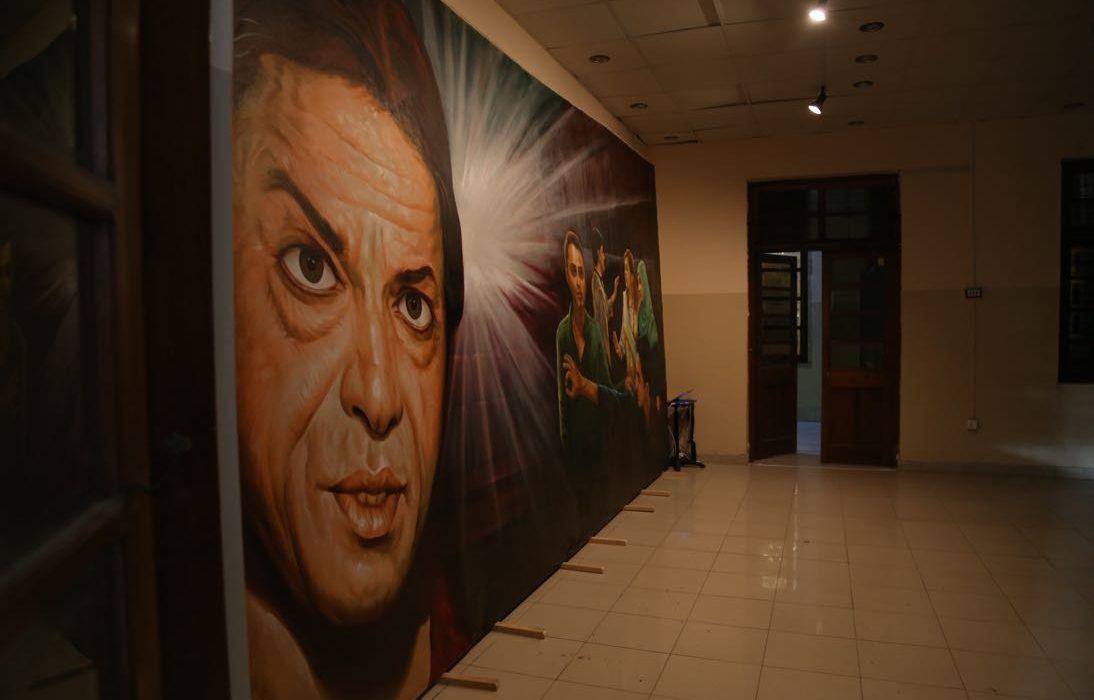Karachi Biennale seeking to engage community through art
KARACHI: Karachi Biennale 2017 (KB17) continued with the art exhibitions in addition to performing art at twelve venues in the city. The opening ceremony of KB17 took place last Saturday at the historical 160-year old Narayan Jagannath Vaidya (NJV) High School, the main venue for the event.
The Biennale has been open to the public from October 22 until November 5 when the closing ceremony of the event will take place at Frere Hall.

The event is Pakistan’s largest international contemporary art event aiming to bring together innovation, excellence and criticality through a multiplicity of curatorial strategies. Seeking to engage the community through art, the Biennale strengthens a global art exchange showcasing artists from Pakistan to the world.
KB17 focuses on the curated exhibits, with over 140 artists from all across the world including Europe, North America, South America, Africa, Southeast Asia and the Far East. To help the audience get an insight into the work and expand interdisciplinary connections with art, the Biennale offers educational and discursive interaction to visitors, also expanding the educational activities to over 300 children.
Three performances at Indus Valley School of Art and Architecture and the Alliance Francaise, titled ‘OVERxCOME’ and ‘Fairytale’ by Miro Craemer and Amy Elizabeth Kingsmill respectively, engaged the visitors. Miro’s interactive performance – a collaboration of Pakistani and German performers and musicians – moved through the grounds of the Indus Valley School, with the audience following the performers across the building.
As a part of the educational activities, over 320 children from four schools in different parts of Karachi came together at NJV High School, VM Gallery, Karachi School of Art, and Alliance Francaise. The programme, engaging school children to connect with art, included visits to the art exhibitions and installations followed by a discussion session.
The programme also brings into its fold art students and educators in the outreach to children. This, in turn, has paved the way for better understanding of practices and mechanisms to make art more comprehensible and accessible for young minds.

Senior art critic Marjorie Hussain chaired the inaugural session with a group of artists, professionals, civil society and businessmen of the city attending the ceremony. The ceremony, with participation from 1,000 members of public from different walks of life, featured a session with visiting artists, a discussion on public art and addresses by chief curator and KB17 CEO.
The Biennale will also feature two prizes to acknowledge the most evocative exhibits in KB17, namely KB17 Mahvash and Jahangir Siddiqui Foundation Juried Prize and the KB17 Shahneela and Farhan Faruqui Popular Choice Art Prize.
The prizes would reflect the Karachi Biennale Trust’s sustained commitment to recognising the effort and impact of participating artists’ work, as it engages with conversations around art, cities, and the ‘act of witnessing’.
Over 140 artists have showcased their work at the Biennale which was displayed at 12 venues all across the city, with five on MA Jinnah Road. The artists have come from Europe, North America, South America, Africa, Southeast Asia, the Far East, and various parts of Pakistan. The works of internationally renowned artists like Yoko Ono, Shahzia Sikander, Richard Humann, Michelangelo Pistoletto, Orlan, Bani Abedi, Meher Afroz, Miro Craemer, Bankleer, and Ruby Chishti, among others, were displayed for a large audience.
To help the audience get an insight into the work and expand interdisciplinary connections with art, BK17 offers educational and discursive interaction to visitors. In this regard, a series of conversations and lectures across two weeks of the event featuring Meher Afroz, Savita Apte , Saquib Hanif, Dr Marek Bartelik, Dr Marcella Sirhandi, Paolo De Grandis, Carlos Aceros Ruiz, Adriana Almada, and Dannys Montes de Oca Moreda, would be held at the ZVMG Rangoonwala Community Centre and the State Bank auditoriums.

Other public events such as poetry and book readings on Karachi, a performance and installation by Jamal Shah, performance works, a sound and light installation by German new media artist Wolfgang Spahn, Dholi Taro (Drum Circle), and project screening at different public spaces in Karachi would also be a part of the Biennale.
The chief curator would be Amin Gulgee, a well-known artist and curator of Pakistan.
This year, the theme of the Biennale would be ‘gawahi’ (witness). Works of art and installations at the Karachi Biennale would be based on this theme, which was chosen for its strong relevance to politics of representation, erasure and selective documentation.
Held in over a 100 countries across the world, art biennales have played an important role in transforming the perception of cities and it is hoped that by organising this inclusive cultural activity in Karachi, KB17 would foreground the city’s vibrant art scene. Local audiences will experience art from other countries and understand its vital link to life, like literature and music.
Since the 1950s, as Karachi grew from a small harbour town to a mega urban centre, it has attracted and embraced independent thinkers and artists. The city has been home to many influential modernists and contemporary artists, with a gallery circuit that is one of the most vibrant in South Asia.
BY ARSHAD HUSSAIN – OCTOBER 30, 2017
Source: pakistantoday.com.pk

